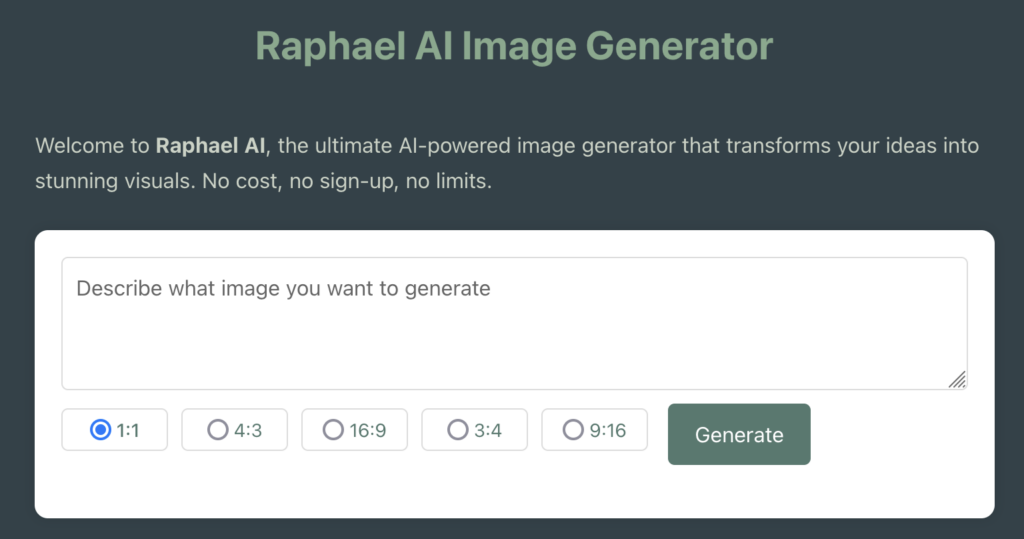When it comes to AI image generation, Leonardo AI is a well-known tool—but its premium plans or usage restrictions might not fit every creative’s needs.
Fortunately, there are several free alternatives to Leonardo AI available. In this comprehensive guide, we’ll introduce our flagship product, Raphael AI, first, then compare other free options, highlighting both their advantages and drawbacks.
1. Raphael AI – Your Free Unlimited AI Image Generator
Raphael AI is our own free, unlimited online AI image generator designed for creators who need high-quality visuals without constraints.

Key Features:
- Unlimited Usage: Generate as many images as you need without daily limits or hidden fees.
- User-Friendly Interface: Simple design suitable for beginners and professionals alike.
- High-Quality Outputs: Leverage advanced AI models for detailed, vibrant images.
- Versatile Applications: Ideal for digital art, social media visuals, marketing materials, and more.
Why Choose Raphael AI?
Unlike many competitors, Raphael AI offers true unlimited generation at no cost. It’s designed to remove barriers and let your creativity flow without the worry of running out of credits or dealing with cumbersome subscriptions.
2. Stable Diffusion Platforms
Overview:
Stable Diffusion is a popular open-source text-to-image model available on many platforms, such as HuggingFace Spaces and DreamStudio’s free tier.
Benefits:
- High-Quality and Realism: Capable of generating detailed and photorealistic images.
- Community Support: Backed by an active community and a wealth of custom models.
Drawbacks:
- Variable Free Access: Some platforms may impose daily limits or require technical setup.
- Inconsistent Interface: User experiences can vary widely across different implementations, which might be less intuitive than Raphael AI’s streamlined design.
3. Craiyon
Overview:
Craiyon, formerly known as DALL-E Mini, offers a completely free experience where you enter a text prompt and receive a 3×3 grid of images.
Benefits:
- Ease of Use: Quick and straightforward for brainstorming or casual art generation.
- Unlimited Access: No subscription fees or hidden costs.
Drawbacks:
- Lower Image Quality: Outputs tend to be less detailed and lower resolution compared to premium models.
- Limited Style and Consistency: The images can appear quirky or inconsistent, which might not meet professional standards.
4. Dream by WOMBO
Overview:
Dream by WOMBO is popular for generating artistic, painterly-style images using AI.
Benefits:
- Creative Output: Produces visually engaging and stylistically unique images.
- Intuitive Interface: Easy for users of all skill levels to navigate.
Drawbacks:
- Over-Stylization: The output is often heavily stylized, which may not be ideal for those seeking photorealism.
- Limited Customization: Fewer control options over specific image details compared to platforms like Raphael AI.
5. Freepik AI Image Generator
Overview:
Freepik extends its design ecosystem with an AI image generator that provides daily free credits for image creation.
Benefits:
- Integrated Resources: Easily combine AI-generated visuals with Freepik’s extensive stock assets.
- Variety of Styles: Offers multiple creative styles to choose from.
Drawbacks:
- Daily Credit Limits: Free usage is capped by a set number of credits per day, restricting continuous workflow.
- Mixed Output Quality: While great for quick designs, the quality may vary compared to unrestricted platforms.
6. NightCafe
Overview:
NightCafe offers an engaging platform with a free daily credit system, allowing users to explore various AI models.
Benefits:
- Multiple Art Styles: Experiment with neural style transfer, VQGAN+CLIP, and other models.
- Community Driven: Active community for sharing and inspiration.
Drawbacks:
- Limited Daily Credits: Users are limited by the number of free credits per day, which can hinder extensive projects.
- Inconsistent Performance: Image quality can sometimes fluctuate depending on the chosen style and model.
7. Playground AI
Overview:
Playground AI provides a straightforward, free-to-use interface for generating images from text prompts.
Benefits:
- User-Friendly: Simple and uncluttered, making it easy to generate images quickly.
- Immediate Results: See your creative ideas come to life in real time.
Drawbacks:
- Credit System: While free, it often comes with a limited number of credits that might restrict heavy usage.
- Less Customization: Fewer options for tweaking advanced parameters compared to Raphael AI.
8. Ideogram
Overview:
Ideogram features a “Magic Prompt” that enriches simple text inputs for more detailed and creative image outputs.
Benefits:
- Enhanced Prompts: Automatically upgrades basic prompts to generate richer, more detailed images.
- Multiple Styles: Offers a range of artistic styles from abstract to photorealistic.
Drawbacks:
- Daily Quota: Free usage is typically limited to a certain number of prompts per day.
- Variable Quality: The enhanced prompts may sometimes result in overly complex images that need further refinement.
There are many free alternatives to Leonardo AI available for creators who want to explore AI-generated art without financial barriers. While each of these tools has its strengths, they also come with certain limitations—such as daily credit limits, lower image quality, or less customization—compared to Raphael AI’s truly unlimited, free experience.
